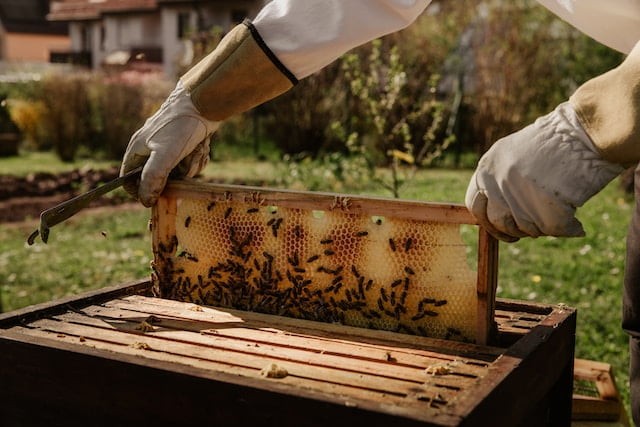
Share this post!
There’s nothing quite like a golden drizzle of honey over cool, creamy yogurt. Or added to a piping hot mug of tea on a chilly evening. Or as part of a spicy but sweet glaze on grilled fish. Or whisked into a homemade dressing for salad fresh from the garden. All uses of honey have their benefits.
The possibilities of how to use honey are endless and only as limited as your imagination.
And honey has a number of health benefits that make it a lovely addition to your diet.
Of course, it must still be used sparingly because honey is still mostly sugar, but unlike processed sugars and alternative sweeteners, honey is so much more than just its sweetness.
Bee Knowledgeable
Honey has been used for health purposes for thousands of years (about 8,000 years to be exact, which we know thanks to artistic depictions from the Stone Age).
Utilized both orally and topically, ancient Greek, Roman, Chinese, Egyptian, Mayan and Babylonian cultures are known to have used honey as medicine, a sweetener and for cosmetic purposes.
As is well known, honey comes from a process in which bees take nectar collected from flowers and break it down into simple sugars. It is sold raw but may also be pasteurized. Honey can be up to 97% carbohydrates, mostly fructose and glucose. It also contains water and organic acids, making honey pretty acidic (usually a pH of around 4).
All nine essential amino acids are found in honey, the highest of which is proline, as are a number of enzymes. Honey also has a small amount of vitamin C, folate, phosphorus, sodium, calcium, potassium, sulfur, magnesium and chlorine, although all of these are in pretty small amounts. This is also true of a number of trace minerals and even heavy metals from the environment.
Bee Healthy

If vitamins and minerals are found in such small amounts in honey, how can it be so beneficial? The answer may in part come from the wide range of nutrients and how protected they are in this golden nectar.
Free radicals can cause oxidative damage and lead to various diseases. But antioxidants prevent this damage and the antioxidants in honey have been found to act as antioxidant agents to prevent oxidative stress. As a rule of thumb, the darker the honey, the higher content of antioxidants.
Additionally, honey acts as an antibacterial and antimicrobial. In fact, it has been found to work effectively against antibiotic-resistant bacteria and biofilms.
Bee Proactive
Probably the most well known ways of using honey medicinally is for wounds and as a cough-suppressant.
Honey has been used for wounds like burns possibly for as long as humans have attempted to find treatments for them, thanks to their triggering of cytokines and because of their ability to fend off infection.
Honey’s power in suppressing coughs have been utilized throughout history. But we now have the science to back it up as well. Studies find that honey works as well or better than pharmaceutical treatments for upper respiratory infection-related cough at night in children. But it should be noted that honey should never be given to anyone under the age of one because of the risk of botulism.
Similarly, there are questions as to whether honey can help with asthma but the research is not conclusive beyond aiding in nighttime coughing from asthma.
Honey contains prebiotics, which can make it a possible supplemental option for supporting beneficial gut flora and therefore overall gut health.
Bee Curious
Beyond the classic honey we all know and love, there are forms of honey or other bee-derived substances that have their own unique qualities and uses.
Royal jelly is also secreted by honeybees but is milky and gelatinous and is what is fed to the queen bee.
Royal jelly seems to contain unique proteins, including major royal jelly protein 1 (MRJP1). Research has linked MRJP1 to the lowering of serum cholesterol and the risk of cardiovascular disease.
The same protein may also lower blood pressure by relaxing smooth muscle cells along blood vessels.
Further studies have looked at royal jelly in improving symptoms associated with menopause, male infertility and Alzheimer’s disease.
Propolis is another product made by bees and is used as a coating to protect their hives. It comes from a mixture of their secretion and tree sap.
Propolis has been found to be effective at combating giardia, type 2 diabetes and other autoimmune disorders, cold sores, and has even been researched against COVID-19.
Probably the version of honey that has everyone buzzing (excuse the pun) these days is Manuka honey.
This honey comes from bees that have pollinated the Manuka tree, found in New Zealand and Australia. It contains an active ingredient called methylglyoxal (MGO) and works especially well topically for wounds, diabetes-related ulcers and acne.
MGO has been found to inhibit somewhere around 60 different bacteria strains.
Similar to Manuka honey but without the name recognition, Tualang honey comes from Malaysia and actually has a higher levels of phenols and flavonoids. It may also work better against gram-negative bacteria, making it a slightly better option for burns.
Bee Careful

The most obvious problem with honey is its sugar content. Although it has a smaller effect on blood sugar levels than sugar, honey is known to spike blood sugar more than agave. This is why agave has become so popular with diabetics and pre-diabetics.
Vegans and others concerned with how their food choices affect animals may also choose agave as an alternative to honey.
Unfortunately, agave does not have the same health benefits as honey, so choosing the right option may depend on your goals and priorities.
Overall, adding honey to your diet for health may be beneficial as an alternative to other sweeteners. But it should not be an excuse to overdo it.
Honey is considered to be about 25% sweeter than sugar so not as much is needed. And the benefits do not require you to guzzle large amounts either.
If you are careful not to go overboard, the value to your health you may get from honey may be even sweeter than the flavor.
Want to find more ways to incorporate honey into your foods? Here are some healthy and delicious recipes:
The Best Liver Recipe: Dianne’s Beef Liver with Figs
Sweet Potato Brownies (Gluten-Free)
Refer a Friend to NTI
Don’t want to back to school yourself but know someone interested in holistic nutrition or natural cooking? Great! Then, you can contribute to NTI’s mission of Creating Optimal Health Through Nutrition Education and make some extra cash in the process! Under our referral program, anyone can earn a $300 gift card of their choice for every new student referred to NTI!
About the author: Maya Strausberg earned her Master Nutrition Therapist certification from NTI before starting her nutrition therapy private practice. She now offers writing and editing services for nutritionists and other health practitioners around the world through her business, Family Tree Nutrition.
Images:
- Image by Chinh Le Duc on Unsplash
- Image by Bianca Ackermann on Unsplash
- Image by Vladimir Gladkov on Unsplash
Share this post!




















